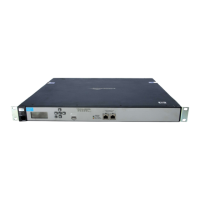Network configuration
IP routes
3-29
The routing table is dynamic and is updated as needed. If more than one default route exists,
the first route in the table is used.
The following information is shown for each default route:
Interface: The port through which traffic is routed. When you add a route, the controller
automatically determines the interface to be used based on the Gateway address.
Gateway: IP address of the gateway to which the controller forwards routed traffic
(known as the next hop).
An asterisk is used by system routes to indicate a directly connected network.
Metric: Priority of a route. If two routes exist for a destination address, the controller
chooses the one with the lower metric.
Persistent routes
Persistent routes are automatically deleted and then restored each time the interface they are
associated with is closed and opened. When the routes are active, they also appear in the
Active routes table.
PPTP client
The controller provides an Auto-route discovery option to enable it to automatically
discover and add routes for IP addresses on the other side of a Point-to-Point Tunnelling
Protocol (PPTP) tunnel. The addresses must be part of the remote domain as specified on the
Controller >> VPN > PPTP client page. Routes are added only when an attempt is made to
access the target addresses.
About PPTP client routes (Internet port)
If you disabled the Auto-route discovery option (VPN > PPTP client), or if you need to
access IP addresses that are not part of the specified domain, you must define the
appropriate persistent routes.
About PPTP server routes (Internet port)
Activation of the route can be triggered by a specific username. When a user establishes a
connection with the controller PPTP server, its username is checked against the persistent
routes list and if a match is found, the route is enabled.

